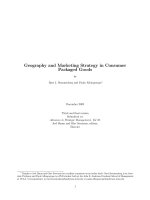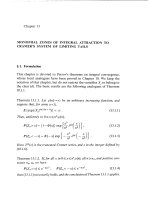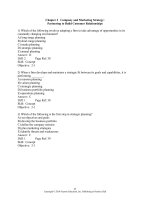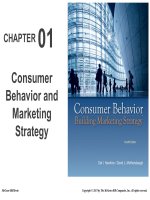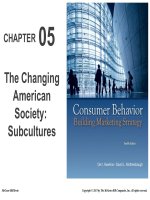Consumer behavior and marketing strategy 12e hawkins motherbaugh chapter 13
Bạn đang xem bản rút gọn của tài liệu. Xem và tải ngay bản đầy đủ của tài liệu tại đây (1.83 MB, 24 trang )
CHAPTER
13
Situational
Influences
McGraw-Hill/Irwin
Copyright © 2013 by The McGraw-Hill Companies, Inc. All rights reserved.
PART IV: CONSUMER DECISION PROCESS
13-2
Learning Objectives
Define situational influence
L01
L01
Explain the four types of situations and their relevance to marketing strategy
L02
L02
Summarize the five characteristics of situations and their influence on consumption
L03
L03
Discuss ritual situations and their importance to consumers and marketers
L04
L04
Describe the use of situational influence in developing marketing strategy
L05
L05
13-3
Consumer Behavior In The News…
What Does Situation Have to Do With It?
Can Timex survive in a time when consumers rely more and more on their phones
to tell time?
No
Yes
If yes, how?
Source: N. Zmuda, “Timex Retools to Address Needs Beyond Time-Telling,” Advertising Age, May 23, 2011, p. 19.
13-4
Consumer Behavior In The News…
What Does Situation Have to Do With It?
Can Timex survive in a time when consumers rely more and more on their phones
to tell time?
No
Yes – if you said yes you are correct!
How? One way is usage situation. Rock climbing….Scuba Diving….Not pulling out
your cell phone then!
Source: N. Zmuda, “Timex Retools to Address Needs Beyond Time-Telling,” Advertising Age, May 23, 2011, p. 19.
13-5
The Nature of Situational Influence
Situational influence includes all those factors
particular to a time and place that do not follow from a
knowledge of the stable attributes of the consumer and
the stimulus and that have an effect on current
behavior.
Consumers often behave very differently depending on
situation.
13-6
Video Application
The following Video Clip demonstrates how going to Las Vegas often
brings about different behavior by consumers!
13-7
13-8
13-8
The Nature of Situational Influence
13-9
The Nature of Situational Influence
Four types of situations:
1.
The Communications Situation
2.
The Purchase Situation
3.
The Usage Situation, and
4.
The Disposition Situation
13-10
Situational Characteristics and Consumer Behavior
Situations can be described on a number of dimensions which determine their influence on
consumer behavior.
The five key dimensions or characteristics are
1.
Physical surroundings
2.
Social surroundings
3.
Temporal perspectives
4.
Task definition
5.
Antecedent states
13-11
Situational Characteristics and Consumer Behavior
Physical Surroundings
Store Atmosphere is the sum of all the physical features of a retail environment.
Atmospherics influences consumer judgments of the quality of the store and the store’s
image.
Atmosphere is referred to as servicescape when describing a service business such as a
hospital, bank or restaurant.
13-12
Situational Characteristics and Consumer Behavior
Physical Surroundings
Typology of Service Environments
13-13
Situational Characteristics and Consumer Behavior
Components of physical surroundings:
1.
Colors
2.
Aromas
3.
Music
4.
Crowding
13-14
Situational Characteristics and Consumer Behavior
13-15
Situational Characteristics and Consumer Behavior
Temporal Perspectives
Temporal perspectives deal with the effect of time on consumer behavior.
Limited purchase time often limits search.
Internet shopping is growing rapidly as a result of
the time pressures felt by consumers.
13-16
Situational Characteristics and Consumer Behavior
Task Definition
Task definition is the reason the consumption activity is occurring.
Major distinction between purchases for self versus gift.
Consumers give gifts for many reasons:
•
social expectations
•
ritualized situations
•
to elicit return favors
AT&T Mother’s Day Commercial
YouTube Spotlight
13-17
Situational Characteristics and Consumer Behavior
Types of antecedent states:
Moods
•
Transient feeling states that are generally not tied to a specific event of object.
Momentary Conditions
•
Temporary states of being (tired, ill, having extra money, being broke, etc.)
13-18
Ritual Situations
A ritual situation is a socially defined occasion that triggers a set of interrelated behaviors that occur in a
structured format and that have symbolic meaning.
Critical to marketers because they often involve
prescribed consumption behaviors.
However, ritual behavior can involve injurious
consumption, such as binge drinking.
13-19
Applications in Consumer Behavior
The Bigelow tea ad is a great
example of presenting a product as
a ritual.
Courtesy R.C. Bigelow: Agency: Mason, Inc.
13-20
Situational Influences and Marketing Strategy
Identify the different situations that might involve the consumption of a product.
Determine which products or brands are most likely to be purchased or consumed across those
situations.
One method of dealing with this question is to jointly scale situations and products.
13-21
Situational Influences and Marketing Strategy
13-22
Situational Influences and Marketing Strategy
Five Steps for Developing Situation-Based Marketing Strategies
1.
Use observational studies, focus group discussions, depth interviews, and secondary data to discover the
various usage satiations that influence the consumption of the product.
2.
Survey a larger sample of consumers to better understand and quantify how the product is used and the
benefits sought in the usage situation by the market segment.
3.
Construct a person-situation segmentation matrix.
4.
Evaluate each cell in terms of potential.
5.
Develop and implement a marketing strategy for those cells that offer sufficient profit potential given your
capabilities.
13-23
Situational Influences and Marketing Strategy
13-24
